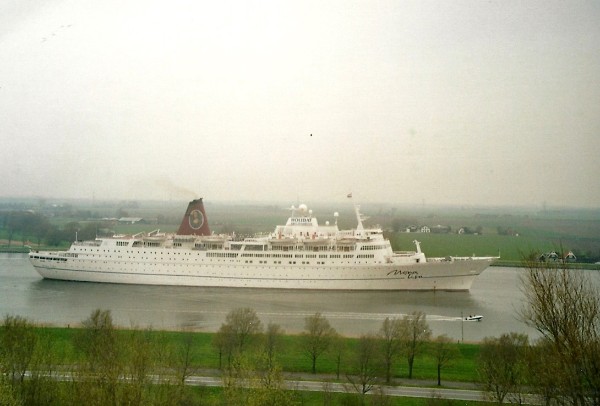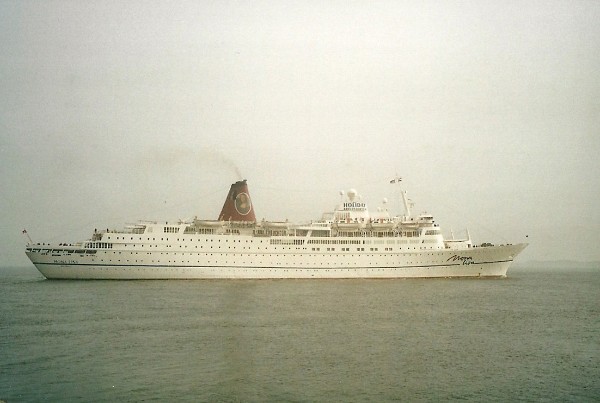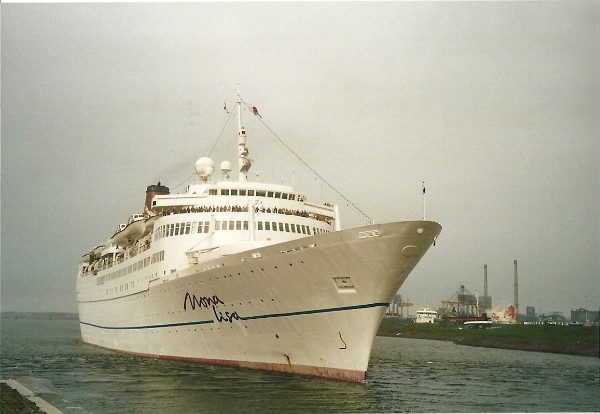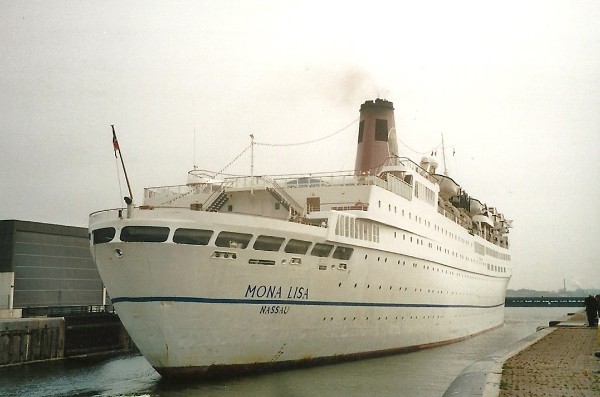Mona Lisa

Mona Lisa is shown at the Northsea Canal near Spaarnwoude at the 23rd of april 2006.
The order for this transatlantic liner was placed by the Svenska Amerika Linjen of Göteborg, Sweden for their service between Göteborg and New York in the early 1960's. This company was formed in 1914 under the name Rederiaktiebolaget Sverige-Nordamerika and started services in 1915. It was planned to build two 18000 ton liners, but this never happened and the company bought the Potsdam fom Holland America Line instead and renamed her Stockholm. Her maiden voyage started in the middle of the first worldwar and took 15 days because she was stopped by a British naval ship and had her mails checked during an extra stop at Kirkwall, England. Starting up a new service in these troubled times was not very convenient, but at least for the first time the country of Sweden had its own steamship line to America. In 1924, their first newbuild Gripsholm entered service, followed by the 1928-built Kungsholm. In 1939, the company had the posession of three big transatlantic liners and all of them survived the war, although one newbuild that was finished during the war was lost under Italian ownership. This ship had to be named Stockholm and was a sister to another new ship that was burned out during the building in 1938.
After the second worldwar, the company ordered another newbuild, but this was a totally different ship then her fleetmates, smaller and especially built for thirth class passengers so no luxury whatsover. This ship was the 1946-built Stockholm, still in service today as Classic International Cruises' Athena, the oldest large passengership in the world. In fact, the Swedish American Line is the only company of whom still two former transatlantic passengerships are existing today.

On the 23rd of august 1963, the Swedish American Line ordered another newbuild, their fourth Kungsholm. The order was placed with John Brown of Clydebank, Scotland. This wharf also built ships like Queen Mary, Queen Elizabeth and Queen Elizabeth 2 for Cunard Line and the new Swedish ship became yardnumber 728 during building. The ship was launched at the 14th of april 1964 and she was again a luxurious one, built with cruising in mind because the company understood that transatlantic voyaging alone was not possible anymore for a ship's lifetime. So the ship was built with many outside cabins and vast lidodecks for her passengers to enjoy the sun. She made her first crossing from Göteborg to New York departing at the 22nf of april 1966, but after this she was mostly used for cruising. The SAL only undertook nine transatlantic crossings during 1966, that were carried out by their two ships, Kungsholm and the 1956-built Gripsholm.
At the time she entered service, Kungsholm was a two-funneled liner with a very classic profile. Her tonnage was 26.678 and she could ferry 108 passengers in first class and 605 passengers in tourist class. As a cruiseship, this number was significantly lower, then she could only take 450 passengers. The passengers were served by 438 crewmembers, although I assume that this number was lower during cruises. The ship was 201,23 meters in lenght, she was 26,52 meters wide and her draft was 8,60 meters. Her normal speed was 21 knots, although she was capable of sailing 25 when needed.
Because it became more and more uneconomical to sail ships under the Swedish flag, at the beginning of the 1970's, the SAL started negotiations with the Swedish trade unions for reflagging the ships to a cheaper country. These negotiations failed in march 1975 and the company decided to stop the passenger services and the ships were put up for sale. Gripsholm was sold in november to Karageorgis Lines of Greece and Kungsholm was sold in october to the P&O owned Flagship Cruises. This company had just transferred its two ships Island Venture and Sea Venture to Princess Cruises as Island Princess and Pacific Princess but the Flagship name was to be retained and Kungsholm became available at the right moment. She even kept her name for Flagship Cruises because she was a very popular ship. The American offices of the SAL were also not very pleased by the discontinuation of the passenger services, they estimated that even under Swedish flag, the ships could sail at a profit.
In 1978, the Kungsholm was transferred to P&O itself and the Flagship name dissappeared. At the 4th of september that year, Kungsholm was send to the Bremer Vulkan yard in Germany to be rebuilt extensively. The biggest exteriour change was the dissappearance of her forward funnel, although the lower part of it still remains. The other funnel was reshaped and new cabins were added. Her tonnage changed to 27.670 and she was now able to sail with 750 passengers in one class. After the refit, the ship was renamed Sea Princess and P&O placed her in the Princess Cruises fleet, the most active passengerfleet of P&O. Under this name, the former Swedish liner was based in Australia as a replacement for former mailship Arcadia, that was scrapped. In 1981, the Sea Princess was placed in the British market, when the Oriana was relocated for cruising down-under. Although she was now more or less a P&O Cruises ship instead of a Princess Cruises ship, her Princess name was retained untill 1995, when she was renamed Victoria and her funnel changed from the Princess white and blue logo to the buff-yellow of P&O Cruises. Meanwhile, as a Princess ship her cabin configurations were changed several times so as Victoria, her capacity was 847 passengers maximum. Her tonnage had also ben changed, she was now measured at 28.891 tons.

Mona Lisa entering the locks at IJmuiden at the 23rd of april 2006.
P&O Cruises started to grow in itself, next to the Princess Cruises brand that had always been their main objective. Next to the Victoria, a brand new large ship entered the P&O fleet under the name Oriana, after the first ship with that name was waved goodbye in 1986. In december 1999, the Victoria was chosen to sail a memorial service for the 100th anniversary of the formation of the Union Castle Line and she was marketed as Edinburgh Castle, recieving the funnelcolours of the Union Castle Line. This memorial was a roundtrip to South Africa of 66 days, so she celebrated the millennium in African waters. The ship was chosen, because of her classic profile she had, although the dissappearance of her forward funnel still makes classic ship lovers angry. The last sailing for P&O started at Southampton at the 22nd of october 2002 and it brought her to Civitavecchia, Rome. The ship had been sold to Leonardo Shipping of Nassau and she was chartered out to the German based Holiday Kreuzfahrten under the name Mona Lisa. For this, she recieved a dark-red funnel with the Mona Lisa painted onto it. A very unusual funnel, but also quite original. A second ship sailed under the name of Lili Marleen, the 1974-built Cunard Countess. The charter would have been for six years, but Holiday Kreuzfahrten was declared bankrupt in mber 2006. For a short period, Mona Lisa was laid up at Piraeus, but later she was chartered as a hotel ship at Doha, Quatar for the Asian Games. This charter ended at the 1st of january 2007.

The aft decks of Mona Lisa are truly the classic aft decks of a former oceanliner. The ship had been in service for 45 years, a remarkable carreer.
This was a very busy year, 2007, because the ship was chartered to Royal Caribbean for use as their Oceanic II under the Pullmantur Cruises brand, although she also was chartered out to Louis Hellenic as a replacement for the Sea Diamond, that had sunk at Santorini, Greece. In september, she was used as a educational ship under the banned of The Scholar Ship, a venture between seven major universities and RCCL. In 2008, the program was discontinued. In april 2008, she was reverted to the Mona Lisa name and sailed for Lord Nelson Seereisen of Germany untill the 31st of august. For the 2008/2009 winter season she was used for the Peace Boat organisation, before returning to Lord Nelson for the 2009 summer season. Between january and march 2010, the now 45-year old liner was used as anaccomodation vessel for the winter Olympic Games at Vancouver, where 1400 persons were housed on board. After this charter, Mona Lisa was back with Lord Nelson untill august when she was taken out of service because she is not up to the 2010 SOLAS-requirements. A plan to bring her home to Sweden and rebuilt her in her former livery and form, including the forward funnel, collapsed and instead, the ship was used as a hotelship in Duqm, Oman. For this, the former liner was renamed Victoria and owned by the Daewoo Group from South Korea. Luckily, the ship was not scrapped, but in Scandinavia, people still wanted to preserve the ship on their own grouds (or seas, of course). In the beginning of 2014, a man from Finland with the name Johnny Sid formed the MS Kungsholm AB, a consortium that signed a memorandum of agreement at the 4th of february to buy the ship and bring her back to Gotheborg or Stockholm after rebuilding her to her original form. This rebuilding is planned to be done somewhere in the Mediterranean region. It is easy to say that this will probably come to nothing, as we have seen so many ideas yet so few realizations. But Johnny Sid is not a newbee, he already preserved the much loved Kristina Regina, that is now in Finland under her original name Bore. Lets hope he can do it again, although we have to be a little scepitcal too, as now there are many plans to preserve ships around the world and it seems only very few can really be operated with profit. Too many ships preserved may become a problem for every moored ship as there will be too few people really interested in the 'old days'.

